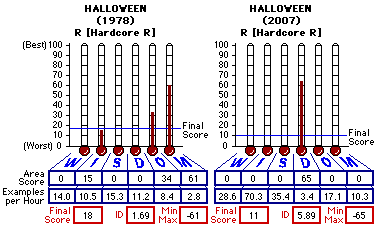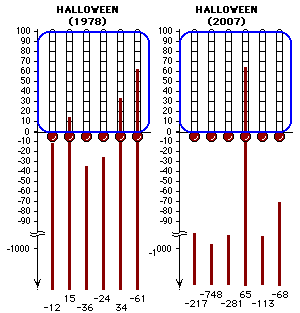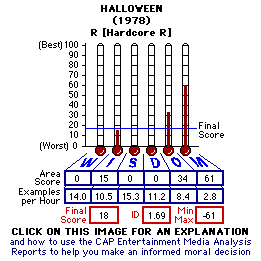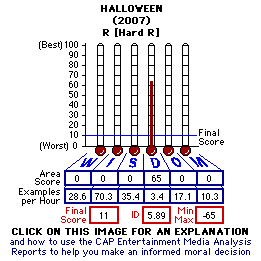

RED does not mean "stop." GREEN does not mean "go." Click on the CAPCon Alert image for explanation |
A ministry of the ChildCare Action Project: Christian Analysis of American Culture (CAP Ministry) A 501(c)(3) Nonprofit Christian Ministry. www.capalert.com/ Entertainment Media Analysis Report A service to His little ones through you in His name by His Word MAR27051 -- A COMPARATIVE  (1978), R [Hard R*] (1hr 26min) (2007), R [Hard R*] (1hr 45min) The #1 Christian entertainment media analysis service on the Internet. We give you OBJECTIVE tools NO ONE ELSE CAN to help YOU make an informed decision for yourself whether a film is fit for your family. Over 1100 analyses for parents, grandparents, pastors, youth leaders and more. |
"http://www.capalert.com/ now_playing.htm" Target="_Blank"  Click it to try it! |
(a PayPal account is NOT required) OR (preferred) by Check or Money Order. The CAP is a 501(c)(3) nonprofit Christian ministry. Donations to us are TAX-DEDUCTIBLE |
on what Hollywood feeds your kids. SUBSCRIBE (or unsubscribe) to our FREE text-only email version of these reports and our COMING SOON notices. |
Christian Long Distance |

(While the Scriptural references are certainly not subjective, my commentary may be and sometimes is somewhat subjective.)
Cast/Crew Details Courtesy Internet Movie Database 1978 Production (US): Compass International Pictures, Falcon Films Distribution (US): Compass International Pictures Director(s): John Carpenter Producer(s): Moustapha Akkad, Debra Hill, Kool Lusby, Irwin Yablans, John Carpenter Screenplay by: John Carpenter, Debra Hill Cinematography/Camera: Dean Cundey Music: John Carpenter Film Editing: Charles Bornstein, Tommy Lee Wallace Production Design: Tommy Lee Wallace Viewed on: Falcon International Productions DVD 2007 Production (US): Dimension Films, Nightfall Productions, Spectacle Entertainment Group, Trancas International Films Distribution (US): Dimension Films, The Weinstein Company, Metro-Goldwyn-Mayer Director(s): Rob Zombie Producer(s): Malek Akkad, Patrick Esposito, Andy Gould, Andrew G. La Marca, Bob Weinstein, Harvey Weinstein, Rob Zombie Screenplay by: Rob Zombie Cinematography/Camera: Phil Parmet Music: Tyler Bates Film Editing: Glenn Garland Casting: Monika Mikkelsen Production Design: Anthony Tremblay Art Direction: T.K. Kirkpatrick Viewed At: Driftwood Theater 6 I decided to conduct analysis of the R-rated Halloween (2007) merely because of the opportunity to get another datapoint for revealing the relative position and movement in the morality content of modern films (and subordinately in society) by preparing a comparison of the analysis of the original R-rated Halloween (1978) with an analysis of its also R-rated 2007 remake. Though in this case the comparative is not that revealing on the surface, indeed by deeper inspection is does reveal a great example of the apparently typical decay in content morality between an original movie and its remake -- a sign of the times [2Tim. 3:1 - 4, Ps. 12:8] and perfect fulfillment of prophesy. This comparative provides also an opportunity to provide a deeper grasp of the features of the CAP Analysis Model. Why do we analyze R-rated films? There are several reasons. None of which have anything to do with enjoying R-rated films. The reasons are posted online at Frequently Asked Questions, Number 5. Rather, we do not "enjoy" watching R-rated (or PG-13) films mainly because of the general stealing of childhood from children they impart. As stated above the 2007 version of Halloween, like its 1978 brother, is rated R. The "R" is no more than a signal. It is not law. And a lot of underage moviegoers take advantage of that fact. Think not? According to a Lowe's Theater intermission slide, more than half of all moviegoers are non-adult. And by one of our own studies, Where's the G!?, Special Report-003, more than half of all films made available to the general public are rated R. You do the math. And, by the way, is there something about becoming 17 years old that makes cinematic sin no longer sinful? One reason we occasionally analyze R-rated films is to maintain integrity of our analysis model. How could we otherwise credibly tell you a PG or PG-13 film earned a score that R-rated films earn? Further, did the Apostle Paul avoid the extremes as he took the Gospel into Corinth? While we do and will continue to analyze a few R-rated films just to maintain the analysis model integrity, we will not analyze NC-17 or X-rated films. Ever. Halloween (2007) is a very "good" example of hardcore R. The story character, Dr. Loomis' description of Michael Myers as "the perfect storm" fits the 2007 version of the film well -- the perfect storm swirling up everything immoral. Just about the only evil not seen is the boiling cauldron with wheezing and cackling demons dancing about it with souls raining down. The 2007 version presents the same basic recipe as the 1978 version but with a lot of plot-compatible embellishments added, most of which are moral poison. Both versions use the same basic plot, the same names with a few new names in the 2007 version and the same Haddonfield, Illinois as Michael's home town. Both use Halloween as the focal date. Both start in 1963. Both use Halloween 1978 as the date Michael escapes the Smith's Grove Sanatorium. One of the embellishments in the 2007 version is that the 27 year old Michael (Tyler Mane) graphically murders five people and mutilates another during his escape from the Smith's Grove sanatorium while in the 1978 version a 23 year old Michael (Tony Moran) attacks a nurse but murders no one during his escape. In the first part of the 1978 version the 6 year old Michael Myers (Will Sandlin) murdered only his promiscuous babysitter teen sister Judith (Sandy Johnson) with a butcher knife. When his parents return to what seems a pleasant and loving home, Michael is carted off to the Smith's Grove Sanatorium. At this plot point the 2007 version contrasts intensely with the 1978 version. Here, the Myers-White home is graphically dysfunctional, vulgar and bitter. The 10 year old Michael (Daeg Faerch) murders his also promiscuous but here brutal sister Judith (Hanna Hall), a neighborhood bully, his sister's boyfriend Steve (Adam Weisman) and his supremely potty-mouthed stepfather Ronnie White (William Forsyth - a new character from the 1978 plot). Only Michael's thong-nude-bikini-top exotic dancer mother Deborah (Sheri Moon) and baby sister, Boo (Sydnie Pitzer, Myla Pitzer, Lela Altman - another new character) are left in the 2007 version. Once the carnage is discovered, young Michael is taken to the Smith's Grove Sanatorium. Eventually Michael's mother, labeled the devil's mother, kills herself leaving Baby Boo alive but in a pool of her mother's blood. After 17 years of treatment by Dr. Sam Loomis (Donald Pleasence - 1978, Malcolm McDowell - 2007) at the Smith Grove Sanatorium, the now enormous 27 year old Michael escapes confinement during a transfer. (where he kills five people and mutilates another) As in the 1978 version, Michael heads back to Haddonfield, Illinois. In the 1978 version, Michael returns to Haddonfield to locate his babysitter, Laurie (Jamie Lee Curtis), which he does and tries to kill her. In the 2007 version Michael returns to Haddonfield to find his sister who, through a little underhandedness of Sheriff Lee ('Leigh' in the 1978 version) Brackett (Charles Cyphers - 1978, Brad Dourif - 2007), has since been adopted as Laurie (Scout Taylor-Compton) by middle-class Cynthia (Dee Wallace) and Mason Strode (Pat Skipper). One of the most invasive embellishments in the 2007 version is the merciless barrage of vulgarity, hatred and viciousness of Michael's dysfunctional family toward the beginning of the film. I doubt there was a single sentence in that house that did not contain some form of hatred, vulgarity, profanity or some other form of moral poison. I am certain this was a plot device added to imply the cause of Michael's dementia and psychopathic nature, but it could have been done differently without losing cinematic power. Though we have not analyzed and will not analyze any NC-17 (or X) film, if NC-17 films had been included in the developmental comparative baseline database I suspect Halloween (2007) would have earned "17-R." We'll never know. A little trivia: in Singapore, the 1978 version is rated NC-17. Halloween (2007) earned a score of zero out of 100 in five of the six CAP investigation areas. R-rated films in the comparative baseline database earned final scores 54 and below out of 100. If it were not for the investigation area score of 65 out of 100 in Drugs/Alcohol (D) the 2007 version would have earned a much lower final score than its 11 out of 100. Though the 1978 version earned above-zero scores in three of the six CAP investigation areas, its final score of 18 out of 100 final score was not that much better the 2007 version. After viewing the 1978 version of Halloween I was all-fired sure it was going to earn a significantly higher final score than the 2007 version simply because it seemed to be "cleaner" than the 2007 version. But when the numbers were crunched the objectivity of the CAP Analysis Model proved me wrong as shown by the scoring distribution comparative below.  One would think a "dirtier" (2007) version would earn a much lower final score than a "cleaner" version (1978). Let me explain why this did not happen. As is shown in the specially prepared scoring display below, depending on the film content any investigation area score shown as zero on the standard data display (the thermometers) may mathematically be less than zero. The standard data display, as shown atop the Findings/Scoring section of an online analysis report, does not show scores of less than zero since less than zero scores are meaningless to the scoring distribution. The standardized scoring methodology is best described as a scoring window -- the blue box in the display below -- transparent only to the scoring columns.  By design, the scoring window is fixed atop scoring columns. Scores may indeed exist mathematically far below the bottom of the window, how far depends on the magnitude of the worst score. But for all intents and purposes less-than-zero scores are meaningless to the viewer. The final score of a film is the average of the zero and above investigation area scores. Less-than-zero investigation area scores are not incorporated into the final score. While the final score is just an average of the investigation area scores inside the scoring window (zero to 100), the investigation area scores are products of more than 30 mathematical operations in every analysis report to include parameters which I will not reveal here in order to protect the copyright of the CAP Analysis Model. So, as shown by the taller scoring columns for the 1978 version, though half of them are beneath zero (under the scoring window), the 1978 version is "cleaner" than the 2007 version. Even the Influence Density scores, 1.69 for the 1978 version and 5.89 for the 2007 version (the higher the figure the more dense the assaults on morality and decency), proclaim the 1978 version is "cleaner." But the "cleaner" of the 1978 version is still "dirty." The view window could be mathematically lowered to produce higher scores for raunchier and raunchier entertainment content but doing so would constitute a mathematically fatal variation from design parameters and would mimic our society which has let its threshold of acceptance become lower and lower each year. We will not compromise the model design parameters because our investigation standards are the Word of God and His Word does not change with the tides of worldly morality -- whether we believe it or not. This "Rock-solid" or "Word-solid" feature of the CAP Analysis Model is how we were able to reveal the relative position and movement of morality in modern entertainment. See our R-13 finding for more information. It is also how we can provide consistent analysis results for films of, e.g., 1950 and earlier to 2050 and beyond. And not just for films but for any form of communication. Highlights of the content revealed by investigation area follow. Please rely on the itemized listing in the Findings/Scoring section for a complete representation of the content found. Wanton Violence/Crime (W) 1978 Matters of violence and/or crime in the 1978 version were largely due to portrayals such as stalking a teen girl, repeatedly; a teen boy murder victim being pinned to a wall with a knife through his chest; a long sequence of pursuit to kill; defensive stabbing and gunfire to kill. 2007 Bully tormenting, threats to kill by an adolescent and graphic beatings repeatedly started the violence/crime content of the 2007 version of Halloween. In addition, teen abuse of an adolescent, stabbing, slicing, impalement, blood gushing, images of contemplation of suicide with a gun, bloody carnage repeatedly, torture by blade and gore comprise a few more examples of extreme ignominy in this version. [Prov. 16:29] Impudence/Hate (I) 1978 The profanity in this version topped off at six uses of the three/four letter word vocabulary. Bully mischief, deceiving parents, babysitter irresponsibility with children in their charge and lying were about the extent of impudent/hate issues. 2007 It seems the most often used word in the 2007 version is not "and" or "the" but is the most foul of the foul words. This single four letter assault on morality seems to comprise the majority of the vocabulary of the teens in the cast, especially the young teens. Teens and adults alike each seemed to certainly have a way with word. No, not a way with words, just a way with word. The most foul of the foul words. Fifty nine times in this 95-minute film. Thirty two of them by teens or an adolescent. Fifty nine is also the number of times the rest of the three/four letter word vocabulary was used, 13 times by teens. [Eph. 4:29, Col. 3:8, Prov. 22:11, Prov. 8:13] The content of the 1978 version revealed by this investigation area earned an area score of 15. The content of the 2007 version revealed by this investigation area earned an area score of minus 748. There is a good example why the 1978 version, though still fully "R", was "cleaner" than the 2007 version. Sexual Immorality (S) 1978 A nearly full gambit of sexually immoral behavior by teens was demonstrated in this version of Halloween: teens making out; teen nudity but no full nudity; inappropriate touch of teens by teens; teens in bed nude for intercourse with hidden nudity; a teen girl baring her chest to entice a teen boy; more. 2007 While the same matters of sexually immoral behavior were noted in the 2007 version as was in the 1978 version, they were more bold, exhibitionistic and frequent in the 2007 version. In addition, due to the raunchier character of this version, the stepfather was noted making sexual lust comments about his teen stepdaughter, a teen girl emulating sounds of an orgasm plus the obligatory homosexual references/comments were noted. While in the 1978 version all issues of nudity were partial and intercourse were presented with hidden nudity, the 2007 version presented full nudity and intercourse with visible nudity. [1Ths. 4:1 - 7, Eph. 5:5, Rev. 22:15, 1Cor. 6:9-10] Drugs/Alcohol (D) 1978 While no drunkenness or drug intoxication was visible in the 1978 version, teens not only drank beer by the bucket and smoked, they smoked dope. Repeatedly. Teens also made it obvious drinking was routine and part of life simply by their talk about it. 2007 While smoking, teen drinking and teen arrogance about drinking were present in the 2007 version, no use of illegal drugs was noted. With an investigation area score of minus 24 due to content of the 1978 version and an area score of 65 due to the content of the 2007 version, the 1978 version was the low scorer regarding alcoholic beverages, illegal drugs and smoking. [Eph. 5:18] Offense to God (O) 1978 Seven uses of God's name in vain without the four letter expletive, 3 times by teens. One use of God's name in vain with the four letter expletive. 2007 Twenty uses of God's name in vain without the four letter expletive, 11 times by teens. Nine uses of God's name in vain with the four letter expletive. One of the properties of stuff in and as entertainment is the emboldenment to mimic. I suspect the writers will be doing some song-n-dance before Jesus about this. [Deut. 5:11] Murder/Suicide (M) 1978 In the 1978 version there are four murders and no suicides. None of the murders are particularly gory. Even when young Michael murdered his sister with a butcher knife there was no gushing of blood, no gore and no visions of the knife penetrating his sister's body. 2007 In the 2007 version there are sixteen murders and one suicide. And each are more gory than any of the fewer murders in the 1978 version. For example, young Michael binds his sleeping stepfather to his chair with duct tape then opens his throat with a knife (plus some other murderous mechanics). Blood spills freely from the open gash. [Rev. 22:15, Gal. 5:21] SCRIPTURAL APPLICATION(S) If needed to focus or fortify, applicable text is underlined or bracketed [ ] or bold. If you wish to have full context available, the Blue Letter Bible is a convenient source. If you use the Blue Letter Bible, a new window will open. Close it to return here or use "Window" in your browser's menu bar to alternate between the CAP page and the Blue Letter Bible page. CHAPTER/VERSE ***Selected Scriptures of Armour against the influence of the entertainment industry*** As always, it is best to refer to the Findings/Scoring section -- the heart of the CAP analysis model -- for the most complete assessment possible of this movie. |
 Wanton Violence/Crime (W) Impudence/Hate (I) Sexual Immorality (S) Drugs/Alcohol (D): Offense to God (O) Murder/Suicide (M)  Wanton Violence/Crime (W) Impudence/Hate (I) Sexual Immorality (S) Drugs/Alcohol (D): Offense to God (O) Murder/Suicide (M) |
| There are some in the entertainment industry who maintain that 1) violent programming is harmless because no studies exist that prove a connection between violent entertainment and aggressive behavior in children, and 2) young people know that television, movies, and video games are simply fantasy. Unfortunately, they are wrong on both accounts." And "Viewing violence may lead to real life violence." I applaud these associations for fortifying 1 Cor. 15:33. Read the rest of the story. From our years of study, I contend that other aberrant behaviors, attitudes, and expressions can be inserted in place of "violence" in that statement. Our Director - Child Psychology Support, a licensed psychologist and certified school psychologist concurs. For example, "Viewing arrogance against fair authority may lead to your kids defying you in real life." Or "Viewing sex may lead to sex in real life." Likewise and especially with impudence, hate and foul language. I further contend that any positive behavior can be inserted in place of "violence" with the same chance or likelihood of being a behavior template for the observer; of being incorporated into the behavior mechanics and/or coping skills of the observer. In choosing your entertainment, please consider carefully the "rest of the story" and our findings. |
| In the name of Jesus: Thank you for visiting us and may God bless you. Prayerfully, we will provide you with some of the most revealing commentary and investigative reporting you have ever read. Lord, Master, Teacher, Savior, God. Tom Carder President ChildCare Action Project (CAP): Christian Analysis of American Culture 100% dependent on your tax-deductible financial support |  |
Christian Long Distance |
|
We exist only by your tax-deductible donations. PLEASE Features PayPal! You do NOT need an account to donate. |
